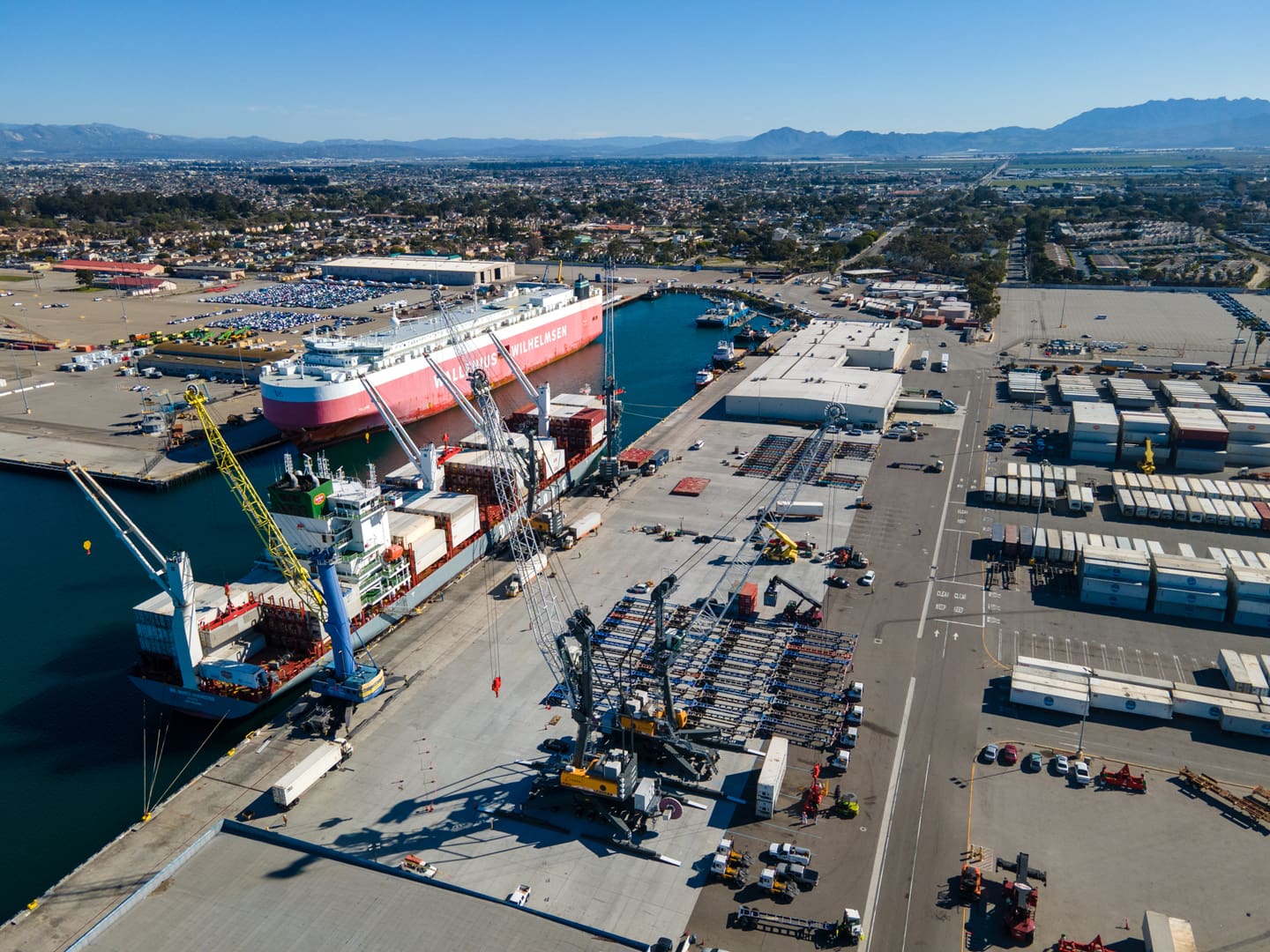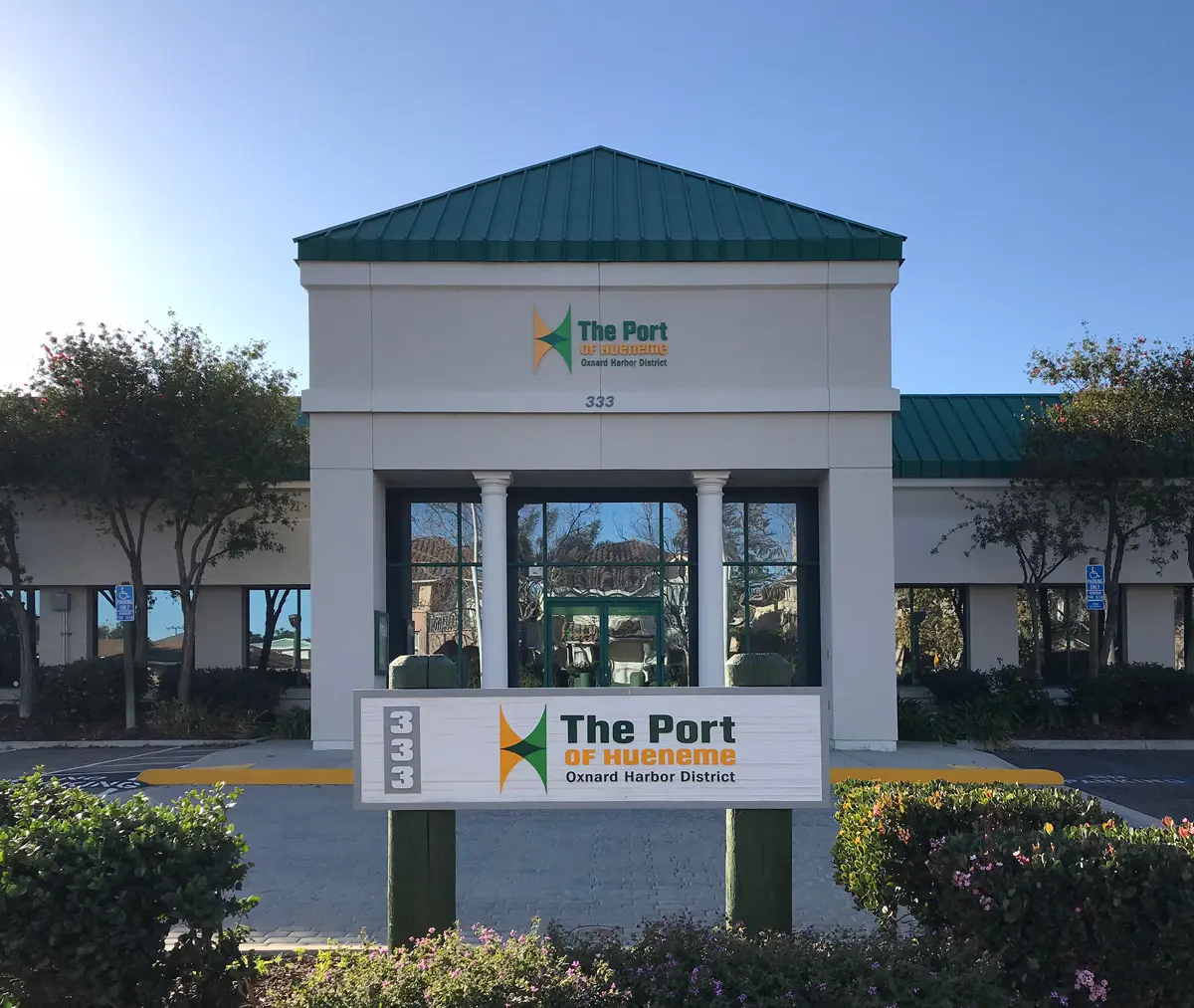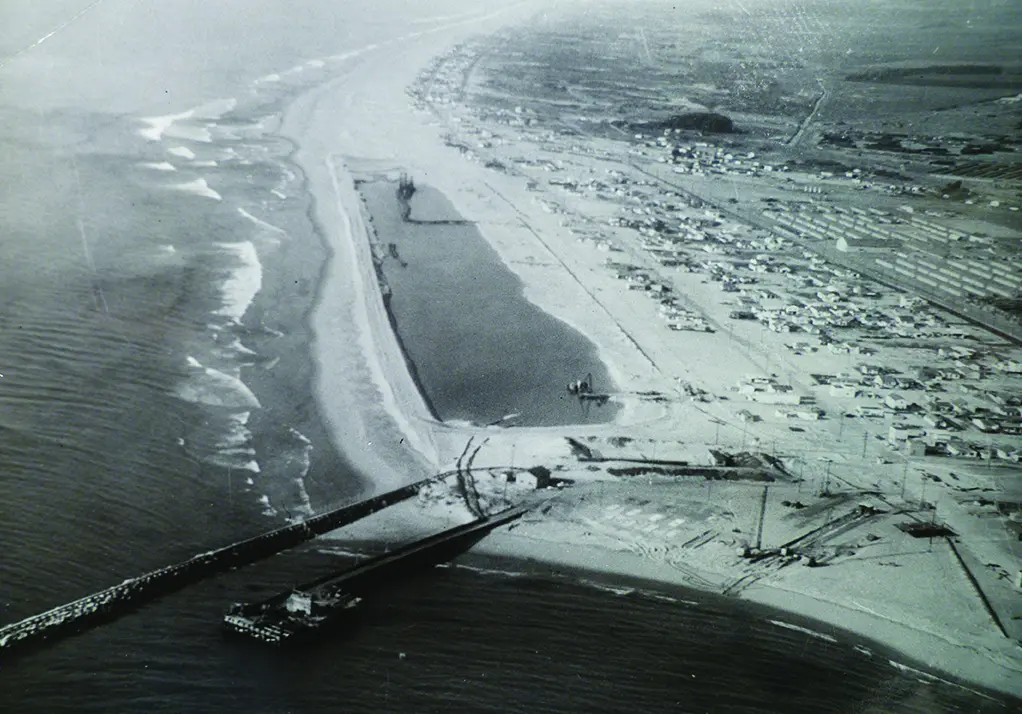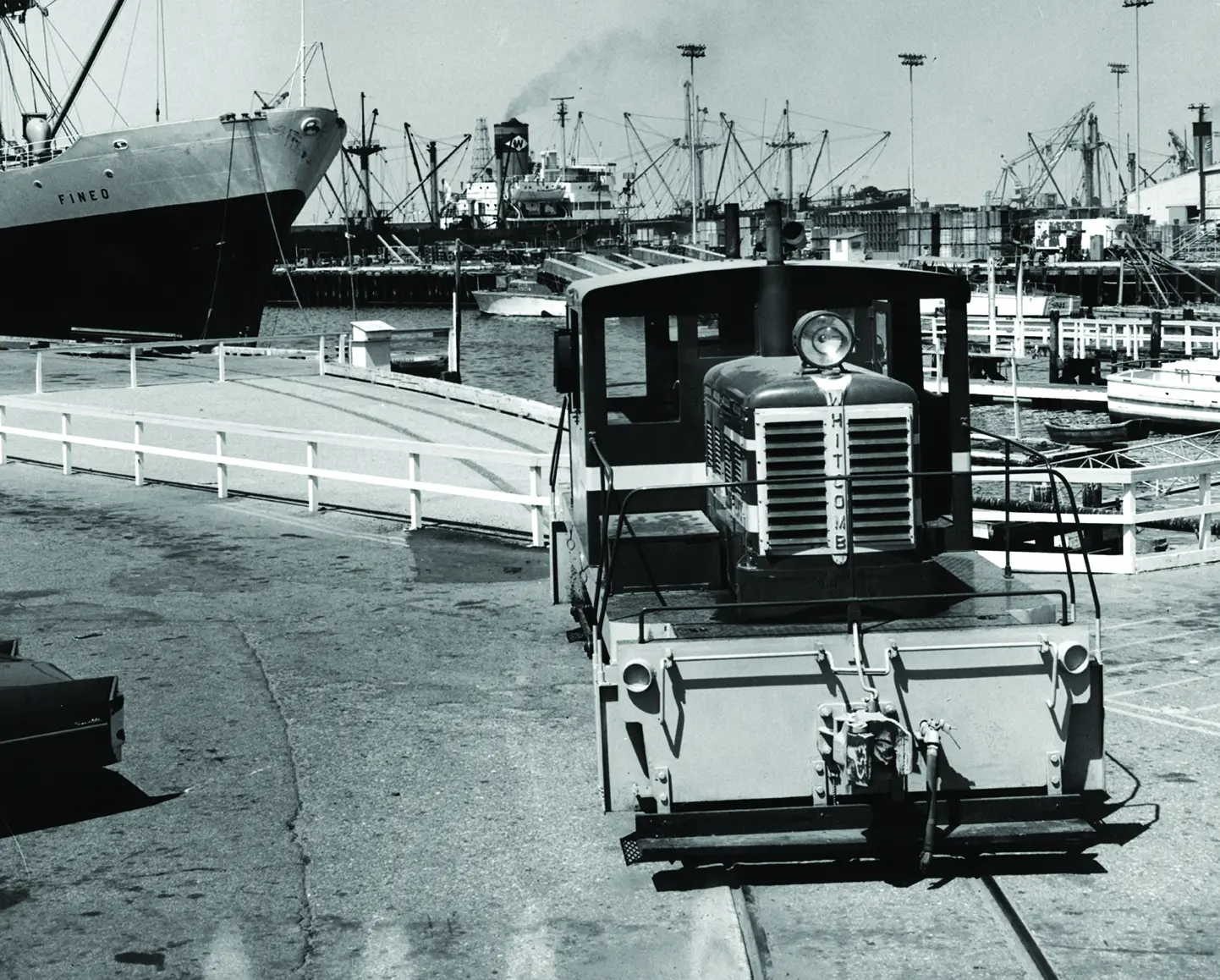Committed to Your Success
The Port of Hueneme welcomed its first vessel in 1941, embarking on an ambitious mission to maximize maritime commerce and provide extensive economic benefits to the community.
Since its inception, the Port’s hallmark has been strong leadership, with the members of the Board of Oxnard Harbor District Commissioners at the helm.
Day to day Port operations are conducted by the Port’s CEO/Port Director and select staff, who administer all policies and operations. Their influence is far-reaching, as the District’s political boundaries encompass the City of Oxnard and the City of Port Hueneme.
Continuity, of course, is indispensable for the shaping of sound, long-term policies. To ensure the needed continuity, the Commissioners’ four-year terms are strategically staggered.
The Port of Hueneme is owned and operated by the Oxnard Harbor District, a political subdivision of the State of California. Nevertheless, the bustling commercial gateway remains vigorously independent – a glowing example of a self-supporting business enterprise.
The District is bound by a charter with the City of Port Hueneme. This agreement gives the District complete authority to acquire, construct, own, operate, control, or develop any and all harbor works or facilities. Underscoring its independence, the District prepares and controls its own budget and fiscal activities in order to reach its wide-ranging objectives.
Despite the staggering expenses associated with operating a busy international port, the Oxnard Harbor District collects absolutely no taxes. Operating funds are generated exclusively by Port-related businesses, which enter into highly productive operating agreements with the “landlord” port. Business-generated revenues in turn enable the Harbor District to fund a variety of support services provided by the City of Port Hueneme.

Key Economic Engine For The Region
A pivotal component in the intermodal logistics supply chain, the Port of Hueneme is a major contributor to the economic health of Ventura County and Southern California. The following is a snapshot of the Port’s key economic contributions.
- $15 billion in annual trade value.
- $2.8 billion in overall economic impact.
- $236 million paid in annual taxes.
- Provides more than 24,997 direct, indirect, induced, and influenced jobs regionally.
- Top trading partners include: South Korea, Germany, the United Kingdom, Guatemala, Costa Rica, Mexico, Ecuador, Peru, and Japan.
Overview
Overview Video – English
Overview Video – Spanish
Port Governance
The Port of Hueneme is owned and operated by The Oxnard Harbor District, created in 1937, as an independent special district (business enterprise) and political subdivision of the State of California. Its mission is to operate as a self-supporting Port that enforces the principles of sound public stewardship maximizing the potential of maritime-related commerce and regional economic benefit.
The Oxnard Harbor District’s policies are set by a five-member Board of Harbor Commissioners elected at large from the District. Day-to-day business operations of the Harbor District are administered by a CEO, Port Director and professional staff.
The Harbor District, by its charter, can acquire, construct, own, operate, control or develop any and all harbor works or facilities necessary to efficiently accomplish its mission. It prepares and controls its own budget, as well as fiscal activities. It is responsible for all Port construction and operations.

The Harbor District
- The City of Oxnard area (population 207,722), the City of Port Hueneme (population 21,979), and unincorporated beach communities.
- Harbor Commissioners are elected by voters of the Oxnard Harbor District at large.
- Four-year terms are staggered to maintain continuity.
Key Economic Engine For The Community
The Oxnard Harbor District collects no taxes, operating entirely on Port business generated funds. As a landlord port, commercial companies enter into operating agreements with the Port. The Harbor District pays significant amounts to the City of Port Hueneme for providing services necessary to support the Port’s activities.
Port Facts
The Port of Hueneme is located approximately 60 miles northwest of the major metropolitan center of Los Angeles. The Port’s physical characteristics make it an ideal harbor. The harbor is also protected from severe storms by the nearby Channel Islands.
- Harbor Depth: Entrance channel 40ft (12 m)
- Channel Length: 2,300 Lft (700 m)
- Turning Basin: 1,200 ft (365 m)
- Largest Vessel: 800 ft (244 m) LOA; 35 ft (10 m) depth, 40ft (12 m)
- Tides: Average rise and fall approx 5.4 ft - 6 ft (1.65 m)
- Anchorages: 2 miles south of the Port Hueneme Lighthouse
- On-Port Terminal:
- 120 acres (Port owned)
- Up to 34 acres (joint use - Port leased)
- Wharfs/Berthing:
- Wharf 1: Berths 1, 2 (900 Lft ea.) - Commercial cargo (183 m)
- Wharf 2: Berths 4, 5 (700 Lft ea.) - Commercial cargo (213 m)
- Berth 3: Fishing vessels
- Berth 6 (1,000 Lft joint use) - Commercial cargo (305 m)
- Wharf 4, 5, 6 (license agreement with Navy)
- 1 shallow draft (320 Lft) - squid fishery (97 m)
- 4 floats approx 600 ft of floating dock - small craft support vessels (183 m)
- Short Haul Rail:
- 13-mile short track (Class III) (19 km)
- Owned by Ventura County Railway, which is owned by the Port
- Operated by Genesee & Wyoming
- Long Haul Rail: Connects to Union Pacific at Oxnard Interchange
- Rail Yard: 8-acre switchyard holds 99 boxcars or 80 auto racks
- Off-Dock Navy Out Lease: 279 acres of privately owned Port industrial property
- Port Parcel: 5-acre off-Port property on Edison Ave (Port leased)
- Off-Dock Private Parcels: 279 acres of privately owned Port industrial property
- Refrigeration:
- 93,000 SF on-dock (Del Monte)
- Off-site distribution centers (Anacapa Fresh 1 & 2, Channel Island Cold Storage, Chiquita, Mission Produce, Seaboard, Del Norte Distribution and Lineage Logistics) 1,000,000+SF temperature controlled facilities; transload operations including fumigation and reefer support; processing for the fish industry, 299 reefer plugs on Port; 700+ off for a total of over 1000
- Cranes: 5 mobile shore cranes available - 3 Ports America, 2 SSA Marine
- Tugs: Brusco Tug & Barge (Port contracted)
- Pilotage: Port Hueneme Pilots Association (Port contracted)
- Labor: ILWU Local #46, Teamsters and Operating Engineers
- Stevedores: SSA Marine, Pacific Ro-Ro, Ports America
- Fuel: TracTide (Port contracted)
- Security: Allied Universal (Port contracted)
History
Port of Dreams – History Video
A Port with a Rich Maritime Heritage
Hueneme’, (pronounced “why NEE me”), is derived from a Chumash Indian word (Wynema) meaning “half-way” or “resting place.” It is believed that central California’s original inhabitants the Canalinos Indians, (part of the Chumash nation), used this coastal point of land (approximately half way between today’s Point Mugu and the mouth of the Santa Clara River) as a resting place as well as from which they departed on fishing expeditions. The point at Hueneme is the closest spot (11 miles) from which to cross the Santa Barbara channel between the mainland and Anacapa Island, a prime Chumash fishing area.
The Port that Farmers Built
The Oxnard Plain where the Port is located is home to some of the most fruitful agricultural land anywhere, growing at one time or another, lima beans, sugar beets, lemons, oranges, walnuts, and a peculiarly stubborn brand of California farmer. The farmers never liked the truck and rail rates they had to pay to get their produce to water. As they watched the loaded trucks and trains go by, bound for Los Angeles, they asked, “Why should we send our stuff down there when we’ve got the ocean at our front door? All we’ve got to do is build a harbor.”
The idea for building a Port at Point Hueneme was the direct result of a coastal exploration by Thomas Bard in 1867. Bard had learned of an unusual submarine valley — Hueneme Canyon, over 1000 feet deep, that came within 300 feet of the proposed channel and how an underground river would keep the channel free of silt. Growing frustrations experienced by Ventura County’s early agricultural industry in getting its expanding grain surpluses to broader markets only tended to confirm Bard’s vision of a port to serve as an entry point for the area’s vast agricultural potential. Taking advantage of Hueneme Canyon, a 1500-foot (Bard’s) wharf was constructed in 1872 to lighter goods between the coast and ships offshore.

The Region’s Agricultural Growth
By the early 20th century, agriculture in Ventura County began evolving, becoming more diversified with the birth of Sunkist in 1893. Lemons appearing on the rich Oxnard plain were destined to outstrip both the lima bean and the sugar beet as the County’s principal crop. The impact of citrus would be immediate and long lasting with the construction in 1922 of two giant Sunkist lemon-packing plants. In an instant Sunkist became one of the port village’s largest employers. Within ten years, the once mighty sugar beet declined to such an extent that the Ventura County Railway removed much of its trackage linking the local ranches.
Agriculture’s continued growth, however, coupled with the decline in rail service, challenged local farmers to create a competitive edge in the marketplace. Leading the way was one of Ventura County’s most influential citizens, Richard Bard, son of Thomas who in his later years served in the U.S. Senate. Senator Thomas Bard though instrumental in the earlier construction of Bard’s Wharf had never given up the idea of a truly modern transportation alternative in the form of a deep-sea commercial port.
Becoming a Commercial Port
By the early 1930s it became clear that the elder Bard’s vision of a commercial port was not an illusive dream. Continuing his father’s efforts, Richard would influence events and shepherd the area into the modern age and he, more than anyone else would bring the vision of a seaport to Hueneme. Bard and the area’s farmers applied for a PWA loan of $1,600,000 to build Port Hueneme. They did their best to prove the project sound — both to government engineers and government economists. To the engineers they cited the presence of the Channel Islands, eighteen miles west of the mud flats where the harbor was to be located. The islands, they said, formed a natural breakwater. They explained how Hueneme Canyon (which alone would save $1,500,000 in dredging costs) came within 300 feet of the proposed channel and how an underground aquifer would keep the channel free of silt. To the economists they cited figures: within trucking distance of Hueneme were 25% of California’s sugar beets, half of its walnuts and almonds, 60 percent of its cotton, practically all its borax and potash, and citrus. The Ventura oil fields were only twelve miles away. The promoters ran a truck from Castaic junction, dividing point for southern San Joaquin Valley traffic, first to the Port of Los Angeles, then to Hueneme. The route to Hueneme was twenty-eight miles shorter, had 432 fewer street crossings, and no electric railroad crossings.
But Harold Ickes, PWA head, ruled that the project did not make sense. As the farmers’ stubbornness grew, they decided to build the harbor themselves — On Election Day, April 29, 1937 led by Richard Bard, the tenacity of the citizens of Oxnard, Hueneme and Ventura County was rewarded with the creation of the Oxnard Harbor District.
The District’s first three Commissioners were Eugene H. Agee, an Oxnard businessman, Elmer O. Green a Hueneme Banker and Fred M. Aggen, a Somis rancher. Frustrated by Washington D.C.’s inability or unwillingness to fund the port’s construction these men proposed a bond issue in the amount of $1,750,000 to fund the project. On May 5th 1938 in less than fifteen minutes after the sale opened, the entire bond issue was fully subscribed. For perhaps the first time in American history a port would be constructed without a cent of federal government money. At that time it was proposed and accepted by the City of Oxnard that the harbor property it had previously annexed be released to the Harbor District and that it should never be a part of any incorporated city.
Groundbreaking for the New Port
On January 24, 1939, the Standard Dredging Company began operations in the channel, although the official groundbreaking ceremonies weren’t held until February 4th, with Oxnard attorney Mark Durley serving as master of ceremonies. Appropriately enough, Richard Bard who was destined to be known as the “Father of Port Hueneme,” was asked to turn the first shovel. The harbor was officially completed by July 4, 1940. The two-day dedication was held over the weekend of July 6 and 7, 1940.
The harbor opened and was closed almost immediately by a labor dispute. The new harbor commissioners, unfamiliar with the ways of the waterfront, had signed a contract with A.F. of L. longshoremen. The C.I.O. led by Harry Bridges affiliated International Longshore and Warehouse Union (ILWU) promptly closed the young port. After this error was rectified and a C.I.O. contract was signed, the Port made some progress but not much. Through the rest of the first year and the whole of the next it considered itself lucky to attract a fish cannery and a kelp-processing plant and to see its new pier and wharf used by lumber steamer. But Hueneme, the farmers felt, still had its future before it.

The War Years
They were right, although very different from what they had intended. With the outbreak of the war in the Pacific, the government now eyed Hueneme; on March 5, 1942, they took over the Port via eminent domain and made it a naval base. Six docks were built with a capacity for nine ships. More than $6 million was spent on 5,205 lineal feet of wharfage, 550,000 yards of dredging, 1,200,000 square feet of building, and thirty-six miles of railroad. Nearby the government built an advance-base depot, a base for the Seabees that were born here, and an amphibious-landing training school. For its money the government got what is probably the most efficient harbor in the world. By the end of the Pacific war Hueneme’s wharves were handling 150,000 tons of cargo a month.
The farmers received $2 million for their port, enough to let them meet bonds and interest plus the satisfaction of having contributed importantly to the Pacific war. But they were back to trucking their crops to Los Angeles.
Usage Agreement with the Navy
Following the end of the Pacific war and the hectic demobilization that followed, negotiations began for the return to commercial operations of the “Port the Farmers Built.” After a series of fitful starts the Navy in 1947 finalized a lease agreement with the Oxnard Harbor District for the District’s original Dock #1 consisting of sixteen acres of the original 322 acres it had been forced to give up five years earlier. By 1960 the Oxnard Harbor District completed a feasibility study by which the District would purchase Dock #1 outright along with 6 additional acres for a total of 22 acres, along with the addition of 35 acres from the city of Port Hueneme. The newly reconstructed Wharf 1 was now 1,800 feet long and able to accommodate up to three ships.
The 1960s saw a new and significant phase in the Port’s development with the exploration of oil deposits in the Santa Barbara Channel. The Port of Hueneme remains to this day an important base for the off-shore oil industry.
Successful Niche Port
The decade of the 70s introduced what was to become the Port’s unique cargo niche. As ports across America turned their focus to containerization an opportunity was created in the breakbulk and ro-ro (auto) specialties.
1977 saw the arrival of Mazda Motors of North America and the Port quickly adapted to this new niche. In fiscal year 1977/1978 a total of 17,300 autos were handled at the Port. As more auto manufacturers and ro-ro carriers such as Wallenius Lines, (today Wallenius Wilhelmsen Ocean) recognized the ideal conditions and location of the Port, more would join the Port community including BMW, Mini Cooper, Roll Royce, Mitsubishi, Suzuki, Land Rover, Jaguar, Volvo, Saab and the Port’s newest customers Hyundai, Kia and Subaru. From the inauspicious beginning with Mazda, it would take 13 years before the Port would handle its one millionth automobile during FY 1990/1991. That same year with more companies coming aboard, the port handled 100,000 automobiles or more for the first time. The Port has established its presence as an important auto port along the West Coast of the United States. Eight years later in FY 1999/2000 the port not only recorded its first 200,000-auto year but simultaneously celebrated its second million cars.
Four years later in FY 2004/2005 the port handled its three millionth automobile, as it approached the 300,000 auto mark.
The 17,300 autos handled in FY 1977/78 would be a poor performing month today.
Searching for a new home, Del Monte Fresh Produce in 1979 chose the Port of Hueneme as their west coast distribution hub and the port seized another niche cargo opportunity. To reinforce its fresh produce niche the port built a 140,000 square-foot refrigerated facility in 1994 for Cool Carriers (later to become NYKCool) and Sunkist Growers and in 1995 a 30,000 square foot facility for Del Monte (which has since been expanded to 86,000 Sq. Ft.). With the arrival of Chiquita Fresh Produce and other customers, the Port is now one of the busiest banana gateways in the country. In addition to bananas from Ecuador, Costa Rica and Guatemala, Port customers also import pineapple, mangos, melons, cantaloupe, avocados and even fresh-cut flowers.
Modern Port
In 1985, the harbor district purchased 22 acres of land from the Navy to expand Wharf #2. The extension and reinforcement of Wharf 2 was completed by 1988 creating a 1,450 linear-foot concrete piling wharf specially designed to support the Port’s growing auto terminal operations as well as high and heavy cargos. In 1992 the port received a long sought port-of-entry designation joining 11 other California ports and kicking off a decade of unprecedented growth. By the 1997/98 fiscal year, the port exceeded the million ton mark in general cargo tonnage for the first time, a mark which has steadily increased ever since.
Today and Looking Towards the Future
The Port implemented its Environmental Management Framework (EMF) in 2012 — a critical element of the Port’s community engagement. The EMF helps guide the integration of sustainability into the Port’s day-to-day operations. This robust environmental document sets strategic action plans in the key areas of air quality, water quality, marine resources, sediments, energy efficiency and climate change. The Port is continuing to develop a clean air plan and is partnering on an air quality monitoring initiative with the Ventura County Air Pollution Control District. The Port’s shoreside power system has been up and running since 2014, allowing refrigerated cargo ships to plug in. The Port of Hueneme has received Green Marine Certification since 2017, and continues to hold the title of Greenest US Port per the 2017 International Green Shipping Summit.
In 2019, the Port’s Maritime Advance System Technology (MAST) program took an exciting new course — working with Matter Labs, the Economic Development Collaborative and the Navy/NAVSEA, FATHOMWERX was born. FATHOMWERX’ charter is to create and maintain a platform to accelerate the delivery of innovative capabilities to the Department of Defense in both port and maritime environments; and to facilitate capability refinement through community, exploration, experimentation, and assessment of promising technology. www.fathomwerx.com
The Port of Hueneme continues to thrive, prosper and makes cargo move.
What's New at the Port
Runners Dash to the Finish in Year Two of the Port/City 5k, Highlighting Fitness and Wellness with Free Community Fair
Port of Hueneme Contact: Zach Baliva Director of Communications & PIO zbaliva@Portofh.org (805) 271-2509 City of Port Hueneme: James Vega City Manager jvega@ci.port-hueneme.ca.us (805)986-6518 Download Press Release PORT HUENEME,…
Read MoreCollaborating for a Brighter Future: FIRST Robotics Competition Dives into Innovation at The Port Hueneme
At a ceremony held at the Port of Hueneme, Jess J. Ramirez was sworn in as president of the Oxnard Harbor District. Ventura County Supervisor Vianey Lopez administered the oath of office.
Read MoreDriving into the Future: Port of Hueneme and NYK Line Sign Historic MOU to Launch Green Automotive Shipping Corridor
At a ceremony held at the Port of Hueneme, Jess J. Ramirez was sworn in as president of the Oxnard Harbor District. Ventura County Supervisor Vianey Lopez administered the oath of office.
Read More

